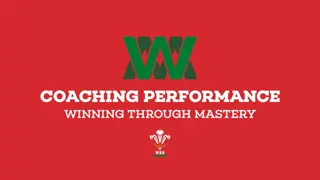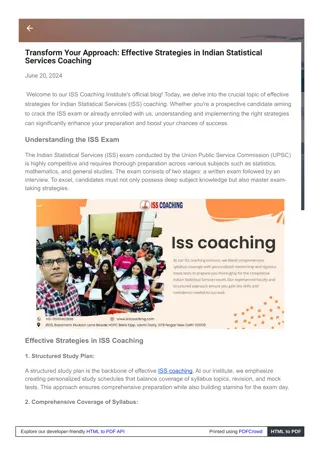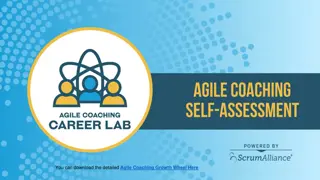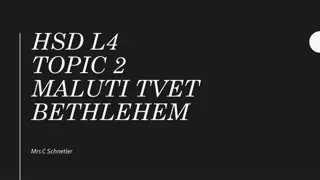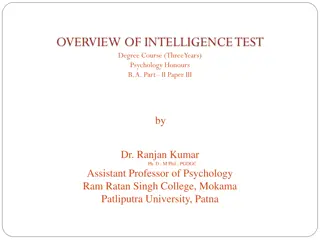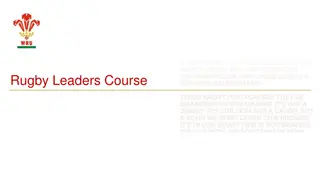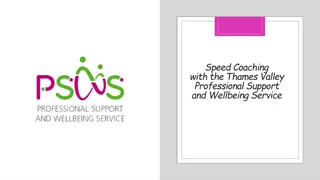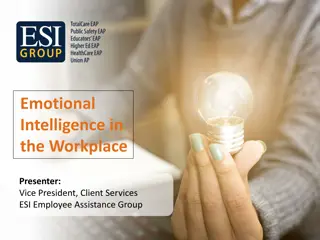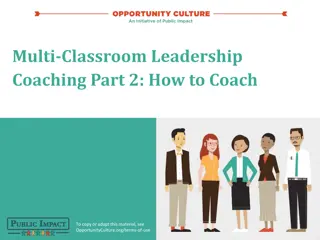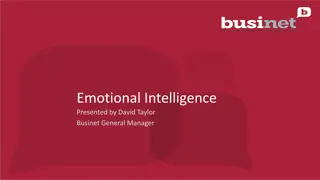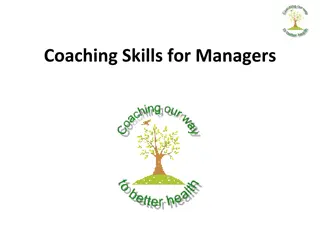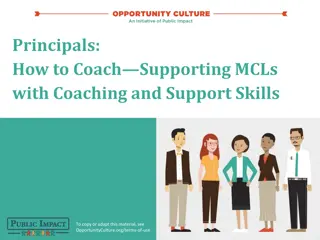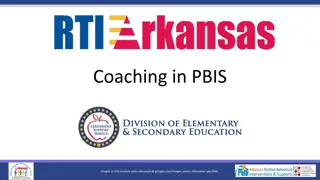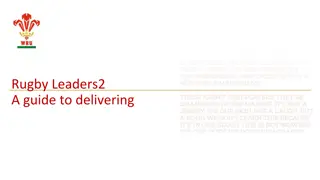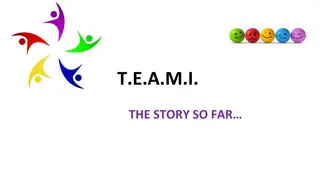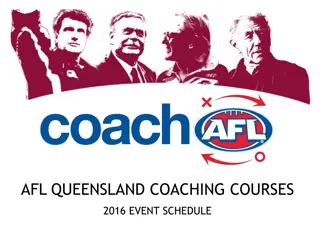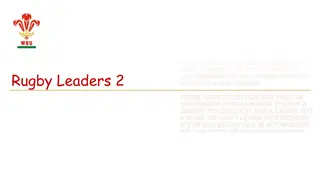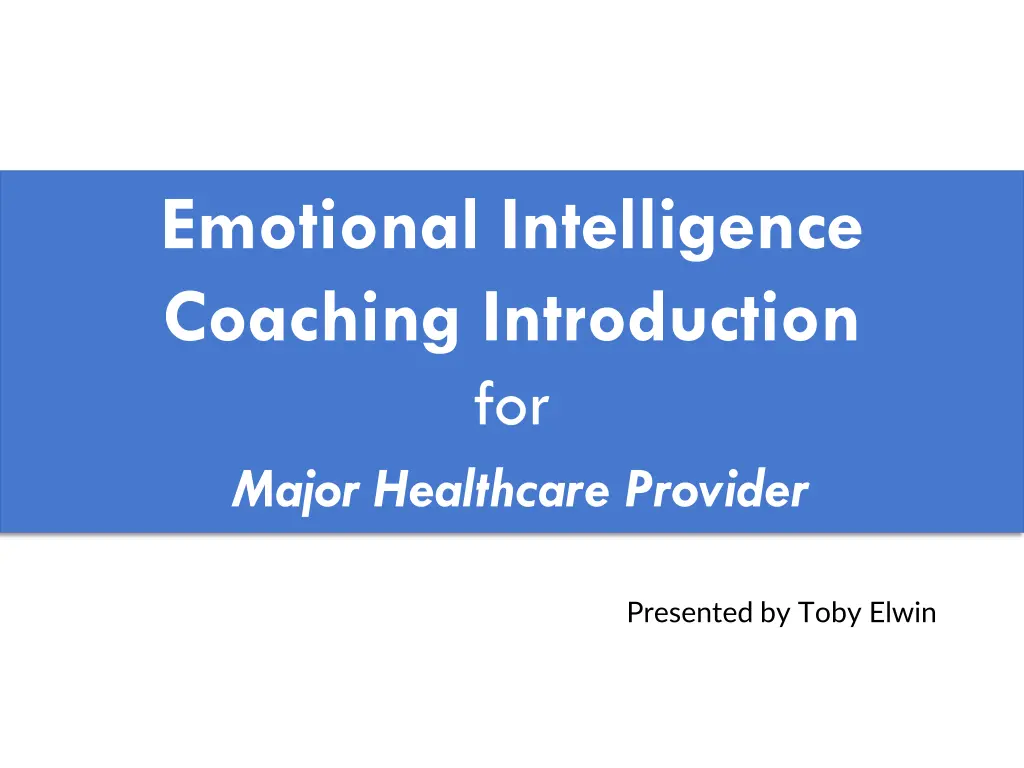
Enhancing Emotional Intelligence in Healthcare Through Coaching
"Explore a comprehensive coaching program designed to enhance emotional and social intelligence for healthcare professionals. The program covers key topics like the ESCI 360 assessment, reading Hay Group's ESCI 360, coaching plan reviews, and resources for continued growth. Join in to develop leadership skills and improve organizational performance in the healthcare setting." (300 characters)
Download Presentation

Please find below an Image/Link to download the presentation.
The content on the website is provided AS IS for your information and personal use only. It may not be sold, licensed, or shared on other websites without obtaining consent from the author. If you encounter any issues during the download, it is possible that the publisher has removed the file from their server.
You are allowed to download the files provided on this website for personal or commercial use, subject to the condition that they are used lawfully. All files are the property of their respective owners.
The content on the website is provided AS IS for your information and personal use only. It may not be sold, licensed, or shared on other websites without obtaining consent from the author.
E N D
Presentation Transcript
Emotional Intelligence Coaching Introduction for Major Healthcare Provider Presented by Toby Elwin www.TobyElwin.com
Coaching Program WebEx - Agenda 90 Minute Agenda: 1. Program overview and goals 2. Putting the ESCI 360 in context 3. How to read the Hay Group s ESCI 360 4. Coaching plan review 5. Program resources and tools 6. Next-steps 2
Agenda 1. Program overview and goals I. Coaching will support the development of enhanced emotional and social intelligence. Research has identified a clear link between moderate to high emotional and social intelligence and more effective leadership and improved organizational performance. II. Review what is Emotional and Social Intelligence: values-based inquiry, strength-based dialogue, desired future state 2. Putting the ESCI 360 in context 3. How to read the Hay Group s ESCI 360 4. Coaching plan review 5. Program resources and tools 6. Next-steps 3
Agenda 1. Program overview and goals 2. Putting the ESCI 360 in context A. September Design Session i. Bedside manner (EI) September ii. High-Performing Teams one-on-one recap iii. Dimensions that support team a. Clear and shared goals or purpose b. Clear and shared roles/responsibilities c. Supportive and empowering relationships d. Clear and shared procedures e. Nurturing and challenging leadership f. Evolving energy and spirit g. Productivity and performance h. Complete, purposeful, and uplifting communication B. December MD team building: i. Matrix management ii. Self-assessment motivating self and others iii. Change and resilience 3. How to read Hay Group s ESCI 360 4. Coaching plan review 5. Program resources and tools: 6. Next-steps 4
We have worked with Emotional Intelligence throughout previous offsite - review Management - Common and unique skills needed to succeed in different fields 25 minutes Organization - Common and unique skills needed to succeed in different organization design 25 minutes Emotional Intelligence - Skills needed to motivate a team 50 minutes Action plan/next steps 10 minutes Ice Breaker 10 minutes Context 10 minutes Dimensions of Team Effectiveness 10 minutes High-Performing Team Interviews 60 minutes Break 10 minutes Data 10 minutes Design 90 minutes Takeaways 10 minutes 5
Relationships in a New Operating Model Clear and shared goals or purpose Clear and shared roles and responsibilities Clear and shared procedures Nurturing and challenging leadership Evolving energy and spirit Productivity and performance Complete, purposeful, and uplifting communication1 1. Self Awareness 2. Self Management 3. Social Awareness 4. Relationship Management Known as Bedside Manner or, more formally, Emotional Intelligence 6
Organization Design - how managers group people together to perform work Five basic organizational structures combine varying elements of bureaucratic and decentralized structures: 1. Functional, 2. Divisional, 3. Matrix Strong Matrix Weak Matrix Balanced Matrix 4. Team, and Question: What skills* are needed to motivate a team? 5. Networking *Skill is an ability acquired through training while competency is a set of defined behavior achieved through skill or knowledge. 7
Leading in a matrix Management Layers More and more organizations are adopting matrix structures, uniting multiple business unites and functions to gain efficiencies and enable cooperation across silos. As the structure of these organizations changes, so too do the competencies required to lead them. Hay Group Matrix Management - review Strong Matrix - Power rests with Project Manager Weak Matrix - Power rests with Functional Manager Balanced Matrix - Power is shared Image source: Hay Group 8
A matrix structure brings potential, but also brings questions. 9
Investment is on an individual ability to motivate themselves and their team How do I work the best? How do I handle stress? How do I expect others to perform? What environment do I excel in? 10
Horizon CBCM ESCI Coaching Program WebEx - Agenda 1. Program overview and goals 2. Putting the ESCI 360 in context 3. How to read Hay Group s ESCI 360 A. Competencies B. Sample C. Case Read 4. Coaching plan review 5. Program resources and tools 6. Next-steps 11
Current default assessment is measure technical skills and IQ to project success Only 10% of job terminations result from technical deficiencies, that is, the inability to do the job. 90% of terminations are due to attitude or behavior problems or difficulties with relationships on the job. IQ is a very poor predictor of job success. Various studies estimate that IQ alone accounts for as little as 4% to 10% of success at work. Technical Skill IQ Studies show IQ and training do not differentiate star performers of people in high-IQ professions that require advanced degrees, such as Ph.D. s and M.B.A. s for entry into a field, groups made up of highly intelligent and trained professionals. The higher people rise in the ranks of management, the more likely they are to have distorted self-perceptions. Senior level managers are likely to rate themselves as much higher on self- awareness and social competencies than their peers and direct reports rate them. 12
High performers have something more critical than IQ and technical skill ? Technical Skill IQ Communication: being able to listen, converse, and present Adaptability: creative responses to setbacks and obstacles Personal management: motivation to work, pride, a desire to develop Interpersonal effectiveness: teamwork, co-operation, the skills to negotiate Organizational effectiveness: leadership potential, the desire to make a contribution 13
People are born with a set IQ that does not change in their lifetime A person s technical skill is acquired through study and experience IQ is Personality? measured Technical Skill IQ Leadership? Disposition? Technical skill is accumulated 14
Technical job ability is not a positive correlation to effective leadershiop What is leadership and can we measure it? Strategy: Vision Business Acumen Courage to Lead Planning Action: Decision-Making Communication Mobilizing Others Results: Risk-Taking Results-Focus Agility Leaders 15
Emotional Intelligence leads to or causes effective or superior performance This competency is an ability to recognize, understand, and use emotional information about oneself or others IQ is Technical skill is accumuated measured Emotional Intelligence Technical Skill IQ Emotional Intelligence is measured, but not Competency is observed fixed 16
But what about culture? Culture Emotional Intelligence Technical Skill IQ What is culture? 1. Ethics: Dominant characteristics of the organization 2. Risk: The explicit values foundational for decisions and actions 3. Trust: The dominant work environment 4. Accountability: The unwritten performance expectations 5. Integrity: Specific behaviors that are valued 6. Alignment: Leaders who walk the walk and who talk the talk 7. Rewards: Criteria of success 17
Emotions and competencies Emotions you feel Emotions are not competencies Image source: Hay Group 18
Competency and behavior What are Competencies? What enables a person to exhibit competency behaviors? Competency is the name given to the specific characteristics necessary to perform a given job well. They differentiate levels of performance in a given job, role, organization, or culture. Competency is any cognitive, physical, or emotional characteristic that leads to outstanding performance in a given job is considered a competency for that job. Image source: Hay Group 19
What are competencies 1. A cognitive intelligence is an ability to think or analyze information and situations that leads to or causes effective or superior performance. 2. An emotional intelligence is an ability to recognize, understand, and use emotional information about oneself that leads to or causes effective or superior performance; and 3. A social intelligence is the ability to recognize, understand and use emotional information about others that leads to or causes effective or superior performance; 20
Professions that require advanced degrees to enter field reveal IQ and training are not what differentiates star performers Fields that require high IQ and training How one manages their self- awareness and their relationships matters in: Conflict Management Coaching and Mentoring Influence Inspirational Leadership Teamwork 21
Competencies Planning and Organizing Building Strategic Working Relationships Meeting Leadership Negotiation Business Acumen Executive Disposition Conflict Resolution Coaching Team Building Initiative 22
Competencies measured by Emotional Intelligence The higher people rise in the ranks of management, the more likely they are to have distorted self- perceptions. Senior level managers are likely to rate themselves as much higher on emotional and social competencies than their peers and direct reports rate them. Personal Competence Social Competence Awareness Self-Awareness Social Awareness Actions Self-Management Relationship Management 23
Competencies measured by Emotional Intelligence Personal Competence Social Competence Awareness Self-Awareness Social Awareness Actions Self-Management Relationship Management 24
Competencies measured by Emotional Intelligence Personal Competence Social Competence Awareness Self-Awareness Social Awareness Actions Self-Management Relationship Management 25
Competencies measured by Emotional Intelligence Personal Competence Social Competence Awareness Self-Awareness Social Awareness Actions Self-Management Relationship Management 26
Competencies measured by Emotional Intelligence Personal Competence Social Competence Awareness Self-Awareness Social Awareness Actions Self-Management Relationship Management 27
Emotional intelligence is distinguishing factor that draws others to us or repels them from us The key to this begins with self-awareness Self-Awareness Social Awareness Self- Management Relationship Management We can assess and measure the four quadrants. We can assess the impact emotional intelligence has on productivity and bottom line results. Competencies are measured as an assessment of observed behaviors. 28
ESCI Coaching Program WebEx - Agenda 1. Program overview and goals 2. Putting the ESCI 360 in context 3. How to read the Hay Group s ESCI 360 A. Sample B. Case Read 4. Coaching plan review 5. Program resources and tools 6. Next-steps 29
General EI How you will benefit What we will cover Leverage emotions to help you think Manage emotions effectively Develop your own emotional blueprint How you will benefit Leading with EI "I hardly ever use the word intelligence, I think of people as either wanting to learn, ambivalent about learning, or rejecting learning. Neil deGrasse Tyson, Director of Hayden Planetarium 30
Competencies measured by Emotional Intelligence Personal Competence Social Competence Self-Awareness Emotional Self-Awareness Social Awareness Empathy Organizational Awareness Awareness Recognizing and understanding our own emotions Recognizing and understanding the emotions of others Self-Management Achievement Orientation Adaptability Emotional Self-Control Positive Outlook Relationship Management Conflict Management Coach and Mentor Influence Inspirational Leadership Teamwork Actions Effectively managing our own emotions Applying our emotional understanding in our dealing with others 31
Agenda 1. Program overview and goals 2. Putting the ESCI 360 into context 3. How to read the Hay Group s ESCI 360 4. Coaching plan review A. Coaching philosophy/principles B. Coaching plan Elite Performance Coaching Plan C. Breakdown of 20 hours D. Coaches i. Review coaching commitment and morals ii. Identification of coaches, and iii. Peer coaching groups E. One-on-one coaching plans F. One-on-one assessment review 5. Program resources and tools 6. Next-steps 35
Coaching obligation Coaches focus: Help the reconcile data Manage the tension by exploring context and aspirations Tension Current State Ideal State Goal 36
Reconcile the data The individual must reconcile their data before they can move forward. Why do I see myself differently from the way others see me? Why do different categories of raters see me differently? Coaching to a 360 instrument. Things to remember: Responses reflect perceptions others have of us People respond to surveys based on the principles of primacy and recency Perceptions are what people see us doing Questions to ask regarding perceptions include: What did others see that make them answer this way? Can you think of a time when you acted in a way that could have led to this perception? 37
Coaching plan overview Coachee: Outcome Goal (Identifies the specific outcome or end state that is desired. Coach: Performance Goals (Identifies the specific performance that is required to achieve the outcome goal.) Start Date: Process Goals (Identifies the specific, measurable activities (what I must do?) to create the desired performance. End Date: Success Metrics for Process Goals (Specific measures that show success in meeting process (activities) goals) Sample Change the perception that I don t meet my deliverables Have my work completed 1 business day before it s due. Block and hold time on my calendar to work on the project. Manage the expectations of my client if I have conflicting priorities When given a new assignment, develop a detailed plan of the work needed to complete the assignment. Identify the resources necessary to complete the work. Say no to requests that are not a priority or that can be done by someone else. Number of detailed plans completed? Number of assignments completed 1 business day before deadline Number of assignments turned in on time. Design source: Gary Best, PhD 39
Performance Goals Coach: Character Lead by example and act as a role model Champion diversity Empower others to achieve; encourage self assurance and confidence Aim High envision the best possible outcome Inspire trust and trust others Model the core values of caring, excellence and integrity Ownership Accept ownership and responsibility for the flawless execution and the highest quality results associated with goals, tasks, projects, assignments, and problem solving Be forthright (honest) about problems and act with urgency to resolve them Anticipate problems and develop cross divisional contingency plans to overcome obstacles Focus on the big picture, using an end-to-end perspective, and act in the best interest of the company as a whole Effective Make it easier to do business with us understand your customer s perspective by putting yourself in their shoes Direct and guide yourself and others towards process and/or continuous improvements; look for better ways to do things Find the right people to quickly diagnose, solve problems, and take action Ensure all activities are aligned with enterprise priorities and long term success factors Develop Coach by regularly giving constructive and timely feedback Recognize and celebrate accomplishments and appropriate behaviors Build a collaborative, inclusive, team environment fostering cross divisional teamwork Give your people stretch goals and provide them with opportunities Create and share successes with others, including internal partners Seek regular feedback for self development Communicate Build cross divisional winning relationships and alliances Communicate clearly, succinctly, effectively, and professionally Share your point of view even when you disagree; fully support the decision once an agreement is reached Seek and welcome other points of view Listen with an open mind Deal directly with uncomfortable situations in a timely manner Design source: Gary Best, PhD 40
Creating the plan for change The plan must be something the person is passionate about Creating the action plan Choose One or Two Areas for Change To change means to hard-wire new behaviors this activity is like building muscle It is easiest to be successful when you focus on one or two things practice developing these muscles for at least six months The goals should be challenging, yet achievable The goals should be measurable and have timelines Specific goals will spell out the expected outcomes and the required support who will provide that? What are the strategies when a person encounters obstacles? 41
Agenda 1. Program overview and goals 2. Putting the ESCI 360 in Context 3. How to read the Hay Group s ESCI 360 4. Coaching plan review 5. Program resources and tools A. Videos, B. Worksheets, C. Reading packets, D. One-on-one calls, E. Team calls, F. Articles, and G. Self-managed study/Community of Practice groups 6. Next-steps 42
Agenda 1. Program overview and goals 2. Putting the ESCI 360 into Context 3. How to read the Hay Group s ESCI 360 4. Coaching plan review 5. Program resources and tools 6. Next-steps A. Review of your ESCI assessment - Look for highlights, surprises, insights; from both the assessor and the coaches point of view B. Set up one-on-one review with coaches C. Review short-term timeline and action items D. Choose a coach 43
Contact @TobyElwin But I don t want to go among mad people, Alice remarked email@TobyElwin.com Oh, you can t help that , said the Cat: we re all mad here. I m mad. You re mad. https://TobyElwin.com How do you know I m mad? said Alice You must be, said the Cat, or you wouldn t have come here. Alice s Adventures in Wonderland, by Lewis Carroll Blog Resources @TobyElwin.com Blog Resources @TobyElwin.com Human Capital Risk Emotional Intelligence Appreciative Inquiry 44

